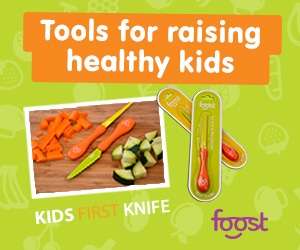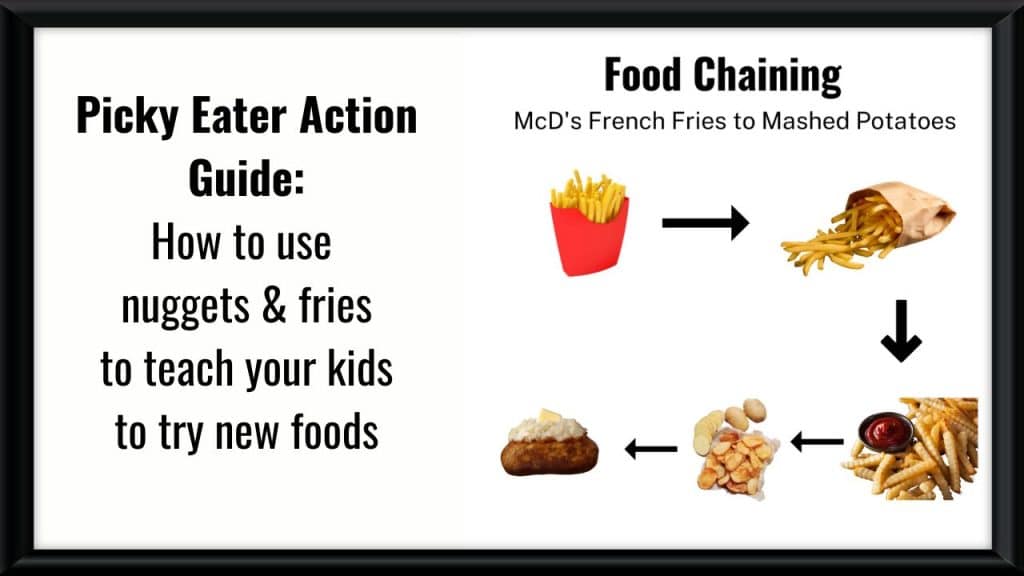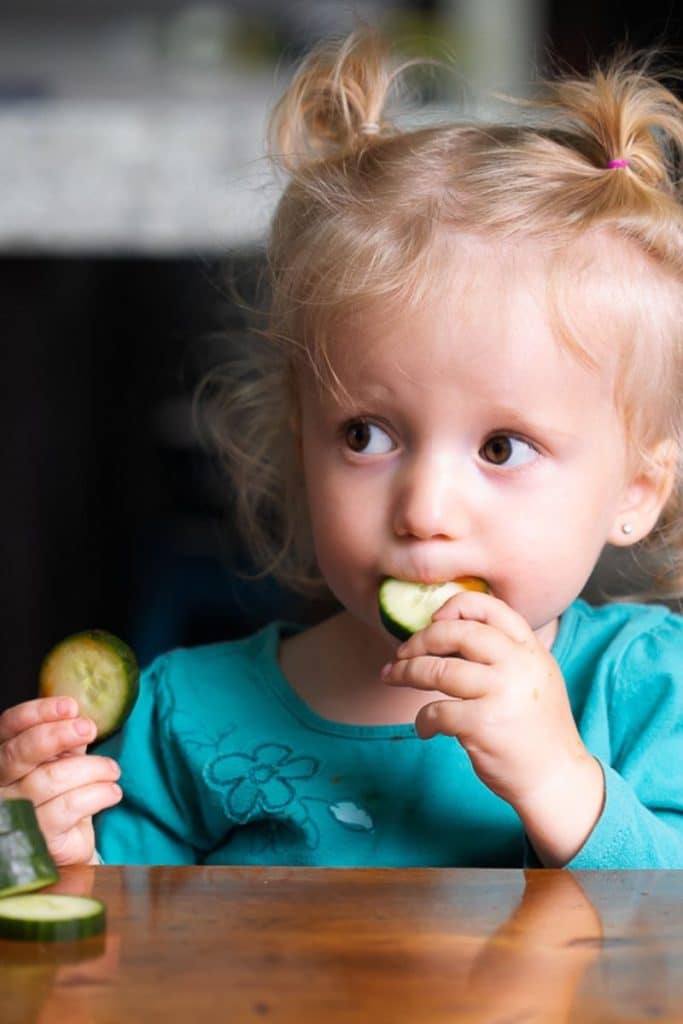
Vegetables for Picky Eaters: 9 tips to help your child eat their veggies
Struggle to get your kid to eat veggies? In this blog our dietitian shares why veggies can be a struggle for kids to eat and tips and recipes to help. This post contains some affiliate links, which won’t change your price but will share some commission
How to get kids to eat vegetables…..as a dietitian, this is one of the most common questions I get. Common tactics include bribing with brownies, rewarding with stickers, or forcing a “no thank-you bite.”
Unfortunately, these methods don’t work long-term. But there’s a lot you can do. In this blog, I share tips, serving ideas, and recipes to help your child learn to taste and love vegetables.
But first of all….
Why do kids hate vegetables?
This might be an exaggeration. Some kids like vegetables! But if you’re feeding fussy eaters, vegetables are one of the most challenging foods for young kids to enjoy.
Why? Kids naturally tend to prefer sweet foods or quick, easy energy sources (hello, sugar and white carbs!). It’s common for children to enjoy fruit but shun more bitter flavours in vegetables, especially if they’re super-tasters with more sensitive taste buds.
In addition, vegetables can also be tougher to chew and swallow, as many of them are very hard and crunchy. So, if your child has weak or underdeveloped oral motor skills, they’re going to avoid raw vegetables.
So what happens if your kid never eats vegetables?
This may come as a shock. But your child can get the nutrients you need without nutritious vegetables!
This is because fruits and vegetables contain many of the same nutrients. For example, folate, vitamin C, and fibre are found in both fruits and vegetables.
That doesn’t mean you quit offering vegetables, but you can relax if your child eats fruit.
But if your child eats very little produce overall and a supplement would make you feel better, check out Juice Plus supplements (affiliate link).
There are whole cookbooks based on sneaking pureed vegetables into your children’s food. Theoretically, hidden veggies sound like a good idea- your child will get their veggies without even knowing, saving the battle.
It’s okay to boost the nutrition in food with vegetables. But I want your child to know that this is a chocolate zucchini muffin or that it’s spinach making the smoothie green.
Hiding the food doesn’t allow your child to experience that particular food and learn to like (or dislike!) it on their own.
Besides, they will also eventually figure you out, possibly leading to distrust of the food you serve and, therefore, a stronger dislike of the hidden food.
Sneaking food into your child is not aligned with the “Division of Responsibility” in feeding.
The Division of Responsibility (DOR) is the cornerstone to creating a healthy relationship with food for your child. Here are the basics: caregivers choose what food is offered, where, and when. And the child chooses how much, or even if they eat.
If the parent sneaks foods into the child’s diet, the child really isn’t consciously deciding whether to eat the food. You are. I know….you don’t think the DOR will work for your picky eater, but check out Sarah’s DOR story here.
Can I bribe my child with dessert if he eats his vegetables?
If your child has to finish their veggies to get dessert, this tells them the veggies are gross. And it puts the dessert up on a pedestal, likely creating a sweet tooth! Read more about managing kids and sweets here.
What about praising or using rewards if they eat vegetables?
To answer this question, I wanted to share a study examining whether kids ate more veggies if you rewarded them.
Ninety-eight preschool-aged children participated. Researchers gave the kids a variety of veggies and found out the least-liked veggie was chicory (a bitter-tasting vegetable). So the authors used chicory as the studied vegetable.
The preschool children were offered a bowl of steamed chicory twice a week. The kids were split into three groups:
1) The first group was simply offered the chicory.
2) The second group was offered the vegetable, along with the promise of a reward (a toy or a sticker) if they ate the chicory
3) The third group was offered verbal praise for eating the vegetable.
The researchers then did a follow-up test eight weeks later. In the group that was just repeatedly offered the vegetable (with no extra reward), 81% rated that they liked the chicory. Then, 68% of those who were rewarded with a sticker or a toy liked the vegetable, and 75% who were rewarded with verbal praise liked the vegetable.
This helps to show that rewarding (which is seen as pressure) actually decreases your kid’s likelihood of actually eating and enjoying the vegetable.
We ultimately want your child to eat using intrinsic motivation, not extrinsic. And they naturally do want to learn and grow!
Should I use the “No Thank you” Bite?
Have tried the “no thank you bite? The 1-bite or 3-bite rules are similar. And they’re not great long-term strategies to help create a healthy food relationship. Or even to try a new food.
Beyond the piles of research showing this to be true, I’ve seen it work with my children.
Once, I offered my family sliced cucumbers with dinner, and this is what happened. My then-three-year-old looked at them and said, “No. I’m not eating these.”
I replied neutrally, “Okay.” Nothing else.
And he ended up eating six slices!
Yet if I had said, “You have to take a bite” or “You have to eat one piece before you have dessert,” there likely would have been screams & fighting.
And maybe he would have taken a bite, but I highly doubt it. And if he did, it would’ve been just one. So, by removing that pressure, he ended up eating more of the cucumber. Give it a try!
Tips to encourage your child to eat vegetables:
Here are some tips that will encourage your child to try vegetables as part of their innate drive to learn and natural curiosity.
Involve your child
Grow a garden (or even a windowsill pot) of vegetables. Visit the farmer’s market and talk to a farmer about how they grow their carrots. Pick out a new vegetable to try at the grocery store.
Involving kids in growing, buying, and preparing vegetables counts as exposure. It will also encourage them to taste the food.
Foost knives are a great tool for getting kids started in the kitchen. Use the code FirstStepNurtrition10 for 10% off of my affiliate link.
Offer them when your child is hungriest
Have you heard that hunger is the best Chef? Things just taste better when we’re hungry. This could be snack time or as an “appetizer” during the witching hour before dinner.
Give the fruit or veggie a funny name
Studies show that if you give a vegetable a catchy name (like “super-sight carrots”), children are more likely to eat it—and eat more of it.
Play with food outside of meal or snack time
There are lots of food play activity ideas online. Check out my Mr. Potato Head on Global! This can be especially helpful if you have a sensory-sensitive child who doesn’t like certain textures.
Food play gives them a chance to play and feel the food. It’s another way to expose your child to food—with zero pressure to eat it, as it’s not mealtime.
Be a good role model
Let your child see you eat fruits and veggies—your kids will eat more veggies themselves!
So offer a small portion of the food whenever you are eating it, even if it’s been repeatedly refused in the past.
You can also try offering these foods with other children around, as kids like to copy each other.
Serve veggies with a dip or sauce
Everyone must admit that celery tastes better with peanut butter, and carrots taste better with dip. Sure, you may get your child licking off the dip…..at least it’s a step that they’re putting the vegetable into their mouth!
Don’t give up
Children can have a fear of new things, called “neophobia.” They also have changing tastes. It may take up to 15 (or more) tries before your child will choose to eat the food.
Make a Food Chain
Food chaining is a method of introducing new foods to picky eaters, building off of foods they already eat. If your child prefers a certain texture, colour, or flavour palate, consider this in the types of vegetables you offer.
For example, if they like crunchy veggie straws, maybe they would try a crunchy green pea. Other crunchy options could be jicama, celery, or iceberg lettuce.
For more information on food chaining and five examples, grab my free download “How to use nuggets and fries to teach kids to try new foods.”
Try a learning plate
Many kids don’t like a preferred food on their plate. They may scream and run away from their entire dinner. But if there’s one pea on a separate “learning” plate, they might be more willing to approach it. Or at least eat the rest of their meal.
They can poke, smell, and lick the food on the learning plate or totally ignore it—it’s up to them!
Best vegetables to try for picky eaters
While some vegetables are hard and bitter, others are easier to start with. Here are some more mild-tasting or sweet vegetables your child might learn to enjoy first.
Home-grown cherry tomatoes
You can grow these indoors in a pot any time of year. Nothing tastes better than fresh-grown produce, and your child will be proud to watch their vegetable grow!
Cucumber
This vegetable has a mild flavour. Add a dip, and you can barely taste it! If they have trouble with the tougher peel, use a small cookie-cutter shape to make fun shapes.
Sweet Potatoes
These are more colourful and sweeter than regular potatoes. Cut them into fries and serve with your child’s favourite dip.
You can also grate sweet potatoes and add them to recipes like this sweet potato and quinoa breakfast tortilla.
Celery sticks
Many picky eaters prefer crunchy foods. To mask the bitter taste of celery, fill it with nut butter, cream cheese, or cheese whiz.
And who remembers ants on a log—peanut butter-filled celery dotted with raisins?!
Different vegetable cooking methods for picky eaters
Offer vegetables cut in different shapes, with different sauces and cooked in different ways. While some kids prefer mushy, over-cooked vegetables, others prefer raw, crunchy, or frozen.
Roasted
Roasting brings out the natural sweetness of vegetables.
Steamed
Steaming will result in a mushier vegetable, which some kids might prefer. Add a bit of butter and salt.
Raw
Don’t cook at all! Some like the crunch of fresh vegetables. With dip, of course.
Air-fried
An air-fryer produces crunchier cooked vegetables if that’s your child’s preference.
Freeze-dried
Eating freeze-dried will be easier for those who don’t like the inconsistency of fresh vegetables from bite to bite. They’re also great for those who prefer crunchy textures, as many picky eaters do.
Frozen
Some kids may prefer to eat frozen veggies like peas and corn straight out of the freezer, especially if they have texture sensory issues. Just like freeze-dried, frozen produce will have the same texture throughout.
Vegetable Recipes for picky eaters
Don’t forget the dip—from hummus to guacamole, even ranch and ketchup for raw vegetables. If your child just licks the dip off, know that even getting the food to their mouth and licking it is quite an advanced step towards eating it.
Here are a few other basic serving ideas:
- Tomato-based pasta sauce. If your child will accept this (just add sauce to one of their noodles to start!), you can mix in other veggies like grated carrots.
- Veggie Kabob. Add raw vegetables to a wooden skewer. Sometimes, just the different serving methods can peak interest.
- Steam broccoli (or “trees!”) and serve with melted cheese sauce. Everything tastes better with cheese…
- Butternut squash soup: It’s creamy, mildly flavorful, and sweet-tastingButternut squash makes a creamy, mild flavour. Maybe your child will try it by dipping it in a breadstick to start.
- Kale Chips: Drizzle pieces of kale with oil and salt (maybe garlic powder) into salted crunchy kale chips. Watch them closely; this only takes a few minutes, and there’s a fine line between perfectly crunchy and burnt!
- Veggie muffins: Spinach, grated carrots, beets, or zucchini can be baked into muffins. If your child enjoys this, you can make cognitive bridges to other forms of carrot, “just like those carrot muffins you love!” Or check out these muffins with added avocado and blueberry.
- Green Monster Smoothie: Throw spinach in a smoothie and make a “Green Monster smoothie.” It turns the smoothie a cool colour, but remember not to “trick” your child with hidden vegetables.
- Roasted Brussels Sprouts with maple syrup and butter: the only way my kids will eat Brussels!
- Fries: Kids tend to like chips and fries, so try serving your veggies in these shapes, too! Cut beets, parsnips, and sweet potatoes into fry or chip shapes (mandolins are great for this) and bake them. Serve with dip, of course.
- Zoodles: Spiralizers are a fun tool. Try serving some zucchini noodles, “zoodles,” alongside regular spaghetti.
- Spaghetti squash is also a great pasta alternative your child might think is fun.
- Vegetable Juice: If you have a powerful blender like a Vitamix (affiliate link), you can juice your own vegetables. A recipe with some fruit added, like this Carrot, Orange, juice is a good place to start.
Conclusion – vegetables for fussy eaters
I hope you now understand why bribing, rewarding, and hiding vegetables can backfire. Instead, remember: “The best thing you can do to get your kids to eat their vegetables and enjoy them is to repeatedly expose them to them—with no pressure at all.”
Want more tips on feeding your picky eaters? Watch my free training: “How to teach kids to try new foods without struggles at dinnertime.”

Founder of First Step Nutrition | Registered Dietitian Nutritionist
Jen believes raising happy, well-nourished eaters who have a healthy relationship with food doesn't have to be a battle! She is an author and speaker with 18 years of experience specializing in family nutrition and helps parents teach their kids to try new foods without yelling, tricking, or bribing.










No Comments